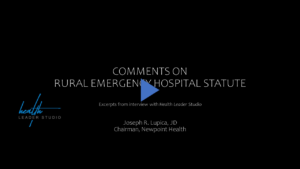![]()
Purpose
The Rural Emergency Hospital (REH) designation offers an enhanced reimbursement formula for hospitals that choose to provide emergency and other outpatient services, but not inpatient services. Created by the Consolidated Appropriations Act of 2021, the REH is a new hospital designation for a rural hospital providing outpatient services (including emergency and observation), but not inpatient services. Conversion to an REH will require informed executive, fiduciary, and community decision-making.
Enrollment Action Plan
Must include a “detailed transition plan that lists the specific services that the facility will retain, modify, add, and discontinue,” as well as the “services that the facility intends to furnish on an outpatient basis.” The detail should be at the level of a robust strategy and business plan of the type that Newpoint would normally prepare for its clients.
An REH Must:
- Have been a CAH, or a “Rural” hospital of 50 beds or less, in operation as of December 27, 2020.
- Not provide acute care inpatient services (note: observation is still an outpatient service)
- Not exceed an annual average per-patient length of stay of 24 hours
- Have a transfer agreement in place with a Level I or II trauma center
- Maintain a staffed emergency department, including staffing 24 hours a day, seven days a week by a physician, nurse practitioner, clinical nurse specialist, or physician assistant
- Comply with Emergency Medical Treatment and Labor Act (EMTALA) regulations
- Meet CAH-equivalent Conditions of Participation (CoPs) for emergency services
- Meet applicable state licensing requirements
- Meet quality reporting standards established by the HHS Secretary.
An REH May:
- Provide an extensive array of outpatient services as supported by its Transition Plan
- Operate a hospital-based RHC and, as a hospital of less than 50 beds, qualify for the RHC per-visit payment limit exception
- Serve as a telehealth origination site (i.e., outbound from patient location)
- Convert back to its prior CAH or PPS status, in accordance with procedures to be established by the Secretary of HHS.
Medicare Reimbursement Elements
- Fee for Service at the Outpatient Prospective Payment System (OPPS) rate, plus a 5% add-on.
- A fixed monthly Additional Facility Payment (“AFP”), which we expect to provide significant support to REHs on a predictable basis. CMS will handle the nationwide calculation of the AFP as follows:
- 2019 actual cost-based reimbursement to all CAHs (for IP, OP, and SNF),
- less the amount CAHs would have been paid under PPS
- divided by the number of CAHs operating in 2019 (the per-CAH amount)
- divided by 12 (i.e., a monthly AFP).
- AFP in future years will be based on the 2023 payment, increased by the national hospital market basket percentage increase.


